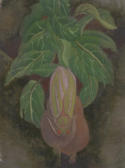



All texts copyright Richard Shillitoe
pitcher plant
c. 1936
Oil on canvas.
7¾ x 5¾in. (20 x 15cm.)
Provenance
NT.
This small painting links the flower paintings of the early-mid 1930s with the more
overtly surrealist works that were to come. It is Colquhoun’s earliest double image,
and combines the pitcher-plant with male genitalia.
Stand close to the painting and the pitcher plant with a flanking pair of corms is clearly visible. Step
back, however, and we realize that we have been examining male genitalia as glimpsed through shadowy
under-growth (the left testicle hanging lower than the right, as is anatomically correct).
This is a very personal view of the Green Man, the male vegetation deity. It is also a work that plays with
the opposites of the container and the contained; of female and male. Anatomically, the vagina is the
container and the penis is the contained. Botanically, the pitcher is a container but here it forms the
phallus. Pitcher plants are carnivorous, capturing flies and insects which crawl into the pitcher and are
unable to escape. The reason why they cannot escape, but are fated to drown in a pool of digestive
juices, is that the passage of the pitcher is lined with downward-pointing hairs which prevent withdrawal.
Colquhoun’s pitcher plant is, at once, penis and vagina dentata. Conjunctio oppositorum has been
achieved, but male sexual fears, of the female genitalia, are here turned onto themselves: this is the
penis which devours itself, a phallus dentata.
The interplay of contained/container and penis/vagina, together with the idea of a predatory vagina
dentata (a female counterbalance, perhaps, to the male surrealists’ usage of mantis imagery) marks this
work as an important new departure in Colquhoun’s continuing fascination with sexuality.
Two pencil sketches and the cartoon are known.
Update
The interpretation offered above is very plausible – but, sadly, it is also wrong. A correspondent from
Australia, Jay Cruikshank, points out that the “plant” is not a pitcher plant, but an insect. Close
examination of the painting and its associated studies confirms Jay’s analysis. Whilst the image is
unquestionably a double image of male genitals, the penis is a wasp and the tentacles a pair of hanging
fruit, most probably pears.
A whole new layer of interpretation suggests itself: rather than the symbolism of the voracious container
as a body double for the penis, future readings of the painting must now focus upon the symbolism of the
stinging insect.


















